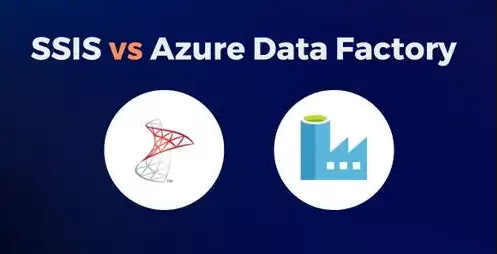
Introduction : ADF vs SSIS: Key Differences Between Microsoft’s ETL Tools
As data volumes explode and cloud adoption accelerates, choosing the right ETL (Extract, Transform, Load) tool is more important than ever. Two of Microsoft’s flagship data integration tools—SQL Server Integration Services (SSIS) and Azure Data Factory (ADF)—often come up in comparison.
So, what’s the difference? In this article, we break down ADF vs SSIS in terms of architecture, use cases, cloud-readiness, performance, and more to help you choose the best tool for your data engineering needs.
🧱 What is SSIS (SQL Server Integration Services)?
SSIS is an on-premises ETL tool that comes with SQL Server. It has been around since SQL Server 2005 and is widely used for tasks like:
- Moving data between systems
- Performing data transformation
- Scheduling ETL jobs
- Running complex workflows
Key Features of SSIS:
- Tight integration with SQL Server ecosystem
- Rich GUI-based development in Visual Studio
- Supports custom scripts with C# and VB.NET
- Control flow and data flow capabilities
☁️ What is Azure Data Factory (ADF)?
Azure Data Factory is a cloud-native, fully managed data integration service in Azure. It allows you to build serverless ETL pipelines that orchestrate data movement and transformation across on-prem, cloud, and hybrid environments.
Key Features of ADF:
- No infrastructure management
- Scalable, pay-as-you-go model
- Drag-and-drop UI + code-first capabilities
- Integration with over 90 data sources
- Mapping Data Flows for visual transformations
🔍 ADF vs SSIS: Side-by-Side Comparison Table
| Feature | SSIS (SQL Server Integration Services) | ADF (Azure Data Factory) |
|---|---|---|
| Deployment | On-premises | Cloud-based (Azure) |
| Setup & Maintenance | Manual setup, patching, and scaling | Fully managed by Azure |
| Scalability | Limited to server capacity | Auto-scalable, serverless |
| UI & Development | Visual Studio | Web-based UI + JSON scripting |
| Integration | SQL Server-centric | 90+ cloud/on-prem data sources |
| SSIS Package Support | Native | Can run via Azure-SSIS IR |
| Monitoring & Logging | Manual setup with SSMS or SSISDB | Built-in portal monitoring |
| Pricing Model | Per server license | Pay-per-use (activity + compute) |
💼 Use Case Scenarios
✅ When to Use SSIS
- Your data infrastructure is still fully on-premises
- You rely on existing SSIS packages
- You require tight coupling with SQL Server
- Your organization prefers static workloads and has invested in SQL licensing
✅ When to Use ADF
- You’re working in a cloud or hybrid environment
- You need to scale quickly without managing infrastructure
- You’re building modern data platforms (e.g., with Azure Synapse, Databricks, or Data Lakes)
- You want to integrate diverse cloud services and automate workflows
🔄 Migrating from SSIS to ADF
Microsoft provides tools to lift and shift your existing SSIS packages into ADF using the Azure-SSIS Integration Runtime. This means you can modernize your ETL workflows without rewriting everything from scratch.
✅ Steps to migrate:
- Deploy SSIS packages to Azure
- Configure Azure-SSIS IR
- Run and monitor using ADF pipeline orchestration
💰 Cost Considerations
SSIS:
- You pay for SQL Server licenses and hardware
- No automatic scaling—more load = more infrastructure
ADF:
- Pay-as-you-go model
- Charges based on:
- Pipeline activities
- Data movement
- Integration runtime usage
👉 Check Azure Pricing Calculator to estimate ADF costs.
🛠 DevOps and CI/CD Support
- SSIS: Uses SSDT, requires manual deployment or third-party tools
- ADF: Built-in Git integration, supports CI/CD via Azure DevOps or GitHub Actions
🧠 Final Thoughts: Which One Should You Choose?
Choosing between ADF vs SSIS comes down to your current infrastructure, future cloud strategy, and workload complexity.
| If You Are… | Recommended Tool |
|---|---|
| A legacy SQL Server shop | Stick with SSIS (for now) |
| Moving to the cloud | ADF all the way |
| Wanting low-code/no-code ETL | ADF |
| Heavy on custom script logic | SSIS |
For many organizations, ADF is the future-proof path forward, offering the scalability, flexibility, and cost-efficiency of the cloud.
📌 Frequently Asked Questions (FAQ)
❓ Can ADF replace SSIS completely?
Yes and no. ADF can handle most ETL tasks, but SSIS still shines for deeply custom workflows, especially on-prem.
❓ Can I run SSIS packages in ADF?
Yes! Use Azure-SSIS Integration Runtime to host and run your existing packages.
❓ Which is better for new projects?
For cloud-first or hybrid setups, ADF is the better choice.
Checkout my other posts : Refactoring a Legacy dbt Project – Lessons Learned from a Healthcare Org